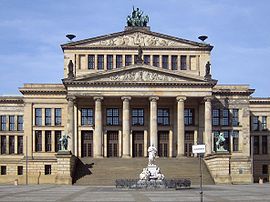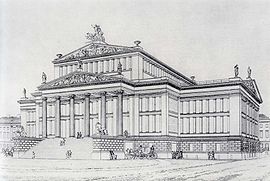
Konzerthaus Berlin
Encyclopedia

Gendarmenmarkt
The Gendarmenmarkt is a square in Berlin, and the site of the Konzerthaus and the French and German Cathedrals. The centre of the Gendarmenmarkt is crowned by a statue of Germany's poet Friedrich Schiller. The square was created by Johann Arnold Nering at the end of the seventeenth century as the...
square in the central Mitte
Mitte
Mitte is the first and most central borough of Berlin. It was created in Berlin's 2001 administrative reform by the merger of the former districts of Mitte proper, Tiergarten and Wedding; the resulting borough retained the name Mitte. It is one of the two boroughs which comprises former West and...
district of Berlin
Berlin
Berlin is the capital city of Germany and is one of the 16 states of Germany. With a population of 3.45 million people, Berlin is Germany's largest city. It is the second most populous city proper and the seventh most populous urban area in the European Union...
housing the German orchestra Konzerthausorchester Berlin. Built as a theatre from 1818 to 1821 under the name of the Schauspielhaus Berlin, its usage changed to a concert hall after the Second World War and its name changed to its present one in 1994.
Prehistory
The building's predecessor, the National-Theater in the FriedrichstadtFriedrichstadt (Berlin)
Friedrichstadt was an independent suburb of Berlin, and is now a historical neighborhood of the city itself. The neighborhood is named after the Prussian king Frederick I.-Geography:...
suburb, was destroyed by fire in 1817. It had been designed by Carl Gotthard Langhans
Carl Gotthard Langhans
Carl Gotthard Langhans was a Prussian builder and architect. His works are among the earliest buildings in the German classicism movement. His best-known work is the Brandenburg Gate in Berlin.- Life :...
and inaugurated on January 1, 1802.
Königliches Schauspielhaus 1817-1870
The new hall was designed by Karl Friedrich SchinkelKarl Friedrich Schinkel
Karl Friedrich Schinkel was a Prussian architect, city planner, and painter who also designed furniture and stage sets. Schinkel was one of the most prominent architects of Germany and designed both neoclassical and neogothic buildings.-Biography:Schinkel was born in Neuruppin, Margraviate of...
between 1818 and 1821.
1821-1870

Carl Maria von Weber
Carl Maria Friedrich Ernst von Weber was a German composer, conductor, pianist, guitarist and critic, one of the first significant composers of the Romantic school....
's opera Der Freischütz
Der Freischütz
Der Freischütz is an opera in three acts by Carl Maria von Weber with a libretto by Friedrich Kind. It premiered on 18 June 1821 at the Schauspielhaus Berlin...
. Other works that have premiered at the theatre include Undine by E. T. A. Hoffmann in 1816. During the 1848 Revolution
Revolutions of 1848 in the German states
The Revolutions of 1848 in the German states, also called the March Revolution – part of the Revolutions of 1848 that broke out in many countries of Europe – were a series of loosely coordinated protests and rebellions in the states of the German Confederation, including the Austrian Empire...
its main auditorium housed the Prussian National Assembly
Prussian National Assembly
The Prussian National Assembly came into being after the 1848 revolutions and was tasked with drawing up a constitution for the Kingdom of Prussia. It first met in the Berlin Singakademie....
for several weeks in September, with the Gendarmenmarkt a major arena of political events.
Preußisches Staatstheater 1870-1944
Notable premieres at the theatre during this period included PenthesileaPenthesilea (Kleist)
Penthesilea is a tragedy by the German playwright Heinrich von Kleist. The play, about the mythological Amazonian queen, Penthesilea, is an exploration of sexual frenzy. Goethe rejected the play as "unplayable".-Plot summary:...
by Heinrich von Kleist
Heinrich von Kleist
Bernd Heinrich Wilhelm von Kleist was a poet, dramatist, novelist and short story writer. The Kleist Prize, a prestigious prize for German literature, is named after him.- Life :...
in 1876, and The Assumption of Hannele
The Assumption of Hannele
The Assumption of Hannele , also known simply as Hannele, is an 1893 play by the German playwright Gerhart Hauptmann. In contrast to Hauptmann's naturalistic dramas, The Assumption of Hannele adopts a more symbolist dramaturgy and includes a dream sequence. The play is the first in world literature...
by Gerhart Hauptmann
Gerhart Hauptmann
Gerhart Hauptmann was a German dramatist and novelist who received the Nobel Prize in Literature in 1912.-Life and work:...
in 1893.
After World War I
World War I
World War I , which was predominantly called the World War or the Great War from its occurrence until 1939, and the First World War or World War I thereafter, was a major war centred in Europe that began on 28 July 1914 and lasted until 11 November 1918...
the Schauspielhaus reopened under the name of Preußisches Staatstheater Berlin in October 1919. Under the direction of Leopold Jessner
Leopold Jessner
Leopold Jessner was a noted producer and director of German Expressionist theater and cinema. His first film, Hintertreppe , is considered a major turning point which paved the way for the later German Expressionist experiments of German filmmakers F.W. Murnau, Fritz Lang, and G.W...
it soon became one of the leading theatres of the Weimar Republic
Weimar Republic
The Weimar Republic is the name given by historians to the parliamentary republic established in 1919 in Germany to replace the imperial form of government...
, a tradition ambivalently continued by his successor Gustaf Gründgens
Gustaf Gründgens
Gustaf Gründgens , born Gustav Heinrich Arnold Gründgens, was one of Germany's most famous and influential actors of the 20th century, intendant and artistic director of theatres in Berlin, Düsseldorf, and Hamburg...
after the Nazi takeover in 1933, including his famous staging of Goethe's Faust
Goethe's Faust
Johann Wolfgang von Goethe's Faust is a tragic play in two parts: and . Although written as a closet drama, it is the play with the largest audience numbers on German-language stages...
and the premiere of Gerhart Hauptmann
Gerhart Hauptmann
Gerhart Hauptmann was a German dramatist and novelist who received the Nobel Prize in Literature in 1912.-Life and work:...
's tragedy Iphigenie in Delphi in 1941.
1944 to present
Severely damaged by Allied bombing and the Battle of BerlinBattle of Berlin
The Battle of Berlin, designated the Berlin Strategic Offensive Operation by the Soviet Union, was the final major offensive of the European Theatre of World War II....
the building was rebuilt from 1977 onwards and reopened as the concert hall of the Berliner Sinfonie-Orchester in 1984 with a gala concert. The exterior, including many of the sculptures of composers by Christian Friedrich Tieck
Christian Friedrich Tieck
Christian Friedrich Tieck , often known only as Friedrich Tieck, was a German sculptor and a brother of Ludwig Tieck.-Biography:...
and Balthasar Jacob Rathgeber, is a faithful reconstruction of Schinkel's designs, while the interior was adapted in a Neoclassical
Neoclassical architecture
Neoclassical architecture was an architectural style produced by the neoclassical movement that began in the mid-18th century, manifested both in its details as a reaction against the Rococo style of naturalistic ornament, and in its architectural formulas as an outgrowth of some classicizing...
style meeting the conditions of the altered use. The great hall is equipped with a notable four-manual pipe organ
Pipe organ
The pipe organ is a musical instrument that produces sound by driving pressurized air through pipes selected via a keyboard. Because each organ pipe produces a single pitch, the pipes are provided in sets called ranks, each of which has a common timbre and volume throughout the keyboard compass...
including 74 stops and 5811 pipes. In 1994 it was renamed the "Konzerthaus Berlin".
Acoustically, the hall is considered to be amongst the five best concert venues in the world for music and/or opera.

